As of April 2024 all lens tables must be built on the LDT-R2. Tables for the LDT-A2 and LDT-M2 can be exported from the LDT-R2 unit so a WCU-4 or Hi-5 is no longer required.
If you have rented the LDT-A2 or LDT-M2 and were not provided with an LDT-R2 (or similar) to build lens tables, please contact your rental house.
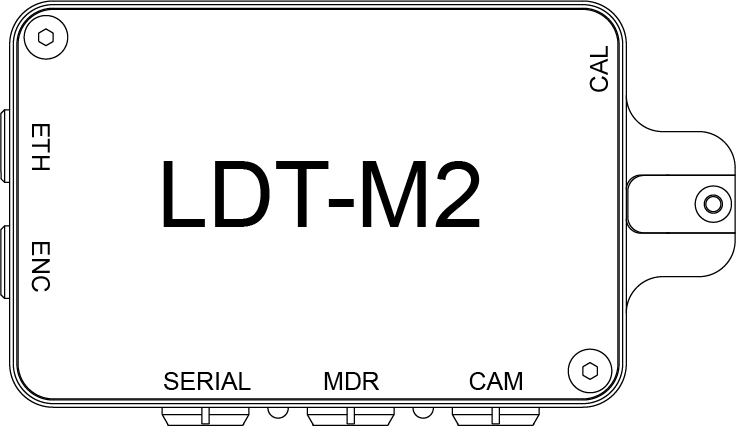
An LDT-R2 is required to make lens tables. Contact the rental house if you have not been provided one.
¶ Introduction
DCS' LDT-M2 is a lens encoding system for the Arri ALEXA Mini, ALEXA Mini LF, ALEXA 35 and ALEXA 265. It reads the Focus, Iris and Zoom motor movements and translates this information into compatible data for the host camera. This metadata is then written directly into the ArriRaw camera files in real time.
Please note: LDT-M2 requires a connection to the camera through the LBUS on the lens mount. If a lens mount is being used which does not have the LBUS port the LDT-M2 cannot record metadata. If this is the case contact DCS and ask about the LDT-V1 which can record the lens data on an SD card.
LDT-M2 Compatibility:
- Preston MDR-3/MDR-4/MDR-5
- Preston HU3/HU4
- ALEXA Mini/Mini LF
- ALEXA 35
- ALEXA 265
Please contact DCS for more information if your device is not listed here.
¶ LDT-M2 Components
The CAM port is labelled LBUS on later models.
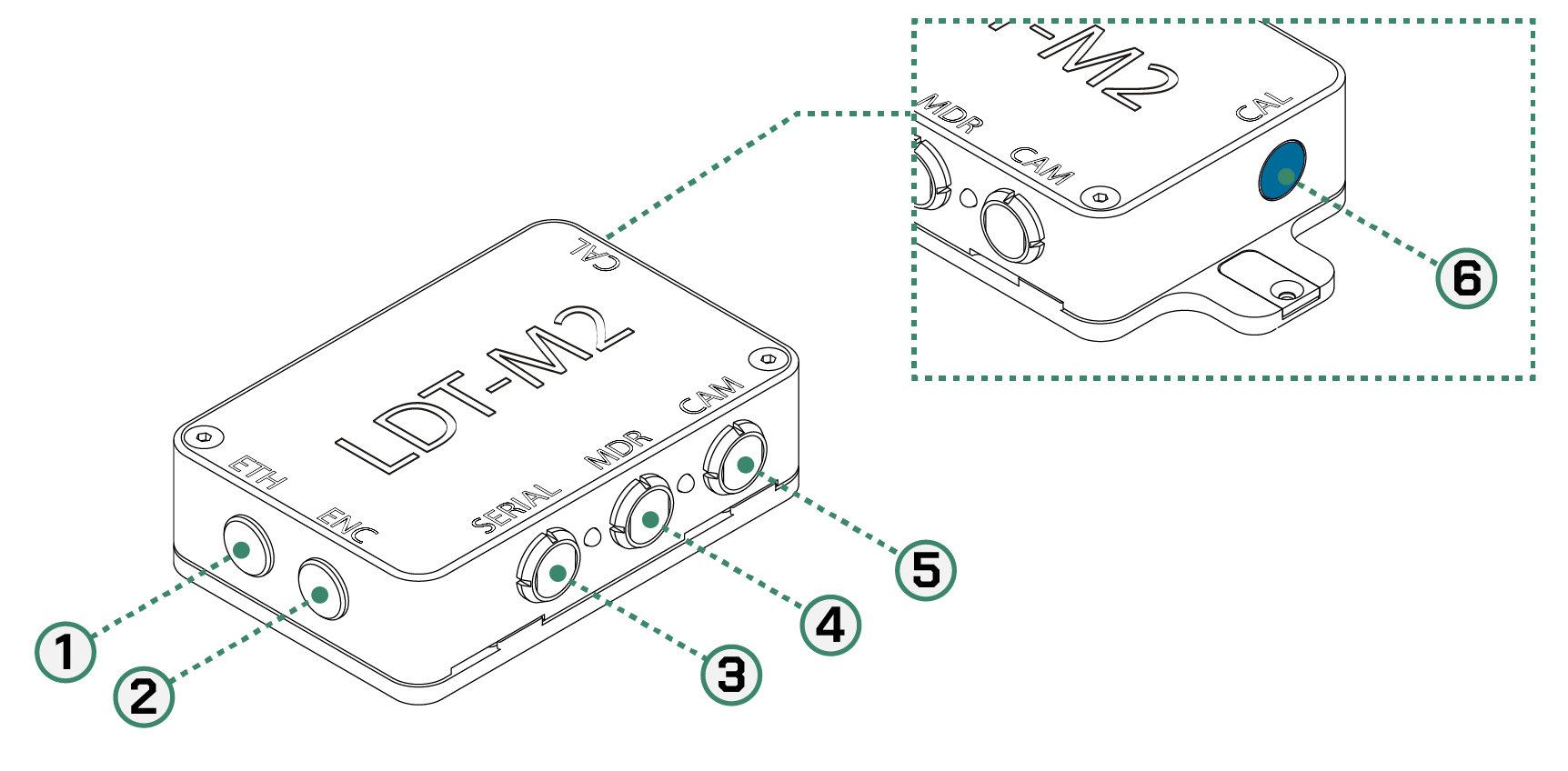
| 1 | ETH | 5-pin 0B Lemo | |
| 2 | ENC | 6-pin 0B Lemo | |
| 3 | SERIAL | 4-pin 0B Lemo | |
| 4 | MDR | 4-pin 0B Lemo | |
| 5 | CAM (LBUS) | 4-pin 0B Lemo | |
| 6 | CAL | Calibration Button (LDT-E Series Only) |
¶ Physical Connections, Power Voltage and Communication
| Name | Type | Description | Cable Codes | Power Voltage | Communication |
|---|---|---|---|---|---|
| ETH | 5-pin 0B Lemo | Ethernet to RJ45 computer connection | ETHA | Industry Standard (+/-2V) | N/A |
| ENC | 6-pin 0B Lemo | Lens data encoder connection port for LDT-E1 | ENC | 5V | N/A |
| SERIAL | 4-pin 0B Lemo | Serial passthrough connection port | CT | 12V | RS232 |
| MDR | 4-pin 0B Lemo | Preston MDR Serial connection port | MDR, MDRP | 12V | RS232 |
| CAM (LBUS) | 4-pin 0B Lemo | LBUS connection to camera | LBUS | CAMBUS |
¶ Cable Types and Codes
All DCS cables are categorized using a code and a bend relief color for each of the cable types. Cables have two default lengths, 12 or 18 or 24 inches and the connector type can be straight (S), right angle (R), or anglissimo (O). Custom cables can be made upon request.
| Code | Bend Relief Color | Type Port Name |
Description |
|---|---|---|---|
| MDRP | Blue | 4-pin 0B Lemo to 4-pin 0B Lemo MDR |
MDRP cable connects the LDT-M2 to a Preston MDR3/MDR4 serial port. Also provides power. |
| LBUS | RED | 4-pin 0B Lemo to 4-pin 0B Lemo CAM |
LBUS cable connects LDT-M2 to the LBUS port of the ALEXA Mini / Mini LF camera. It injects the encoded data into the RAW file. |
| ENC | Green | 6-pin 0B Lemo to 6-pin 0B Lemo ENC |
ENC cable connects the LDT-E1 to the LDT-M2. Look at Using a Lens Data Encoder |
| CT | Orange | 4-pin 0B Lemo to 6-pin 1B Lemo SERIAL |
CT cable connects the Preston MDR3/MDR4 serial port with a CineTape. This cable connects to the LDT-M2 Serial connector if the Preston MDR serial ports are in use. |
¶ Updating the LDT-M2 Firmware
The LDT-M2 should come up-to-date with the most recent firmware. If you need to check the firmware or update for some reason please get in contact with where you rented the LDT or DCS.
If you are from a rental house and are looking for firmware update information this can be found in the LDT-Tester manual on the rental house support site here.
¶ Lens Mapping
Full guide for lens mapping can be found here: Lens Mapping Guide
Creating accurate map files for each lens is vital when using the LDT.
Lens maps must be created on the provided LDT-R2 unit.
The lens files will then be converted for use with the Alexa camera and imported into the body via the USB’s LDA folder.
If lens maps have already been created and imported, then skip this section.
A step-by-step mapping guide can be followed to ensure that maps are built correctly.
If the equipment supplier did not provide an LDT-R2, please contact the appropriate rental house, where you can obtain an LDT-R2 mapping unit at no extra charge.
Ensure that the LDT-M2's LBUS cable is NOT used on any other LDT unit.
¶ Rigging the camera
Incorrectly connecting the LDT-M2 can damage the unit. The LBUS port of the camera should never be connected to the MDR or SERIAL ports of the LDT-M2. Follow all instructions below carefully.
For the ALEXA 35 connect the LBUS cable (red) to either of the LBUS ports on the front of the camera. If either port is not operational please contact the camera rental house.
Ensure that the LDT-M2's LBUS cable is NOT used on any other LDT unit.
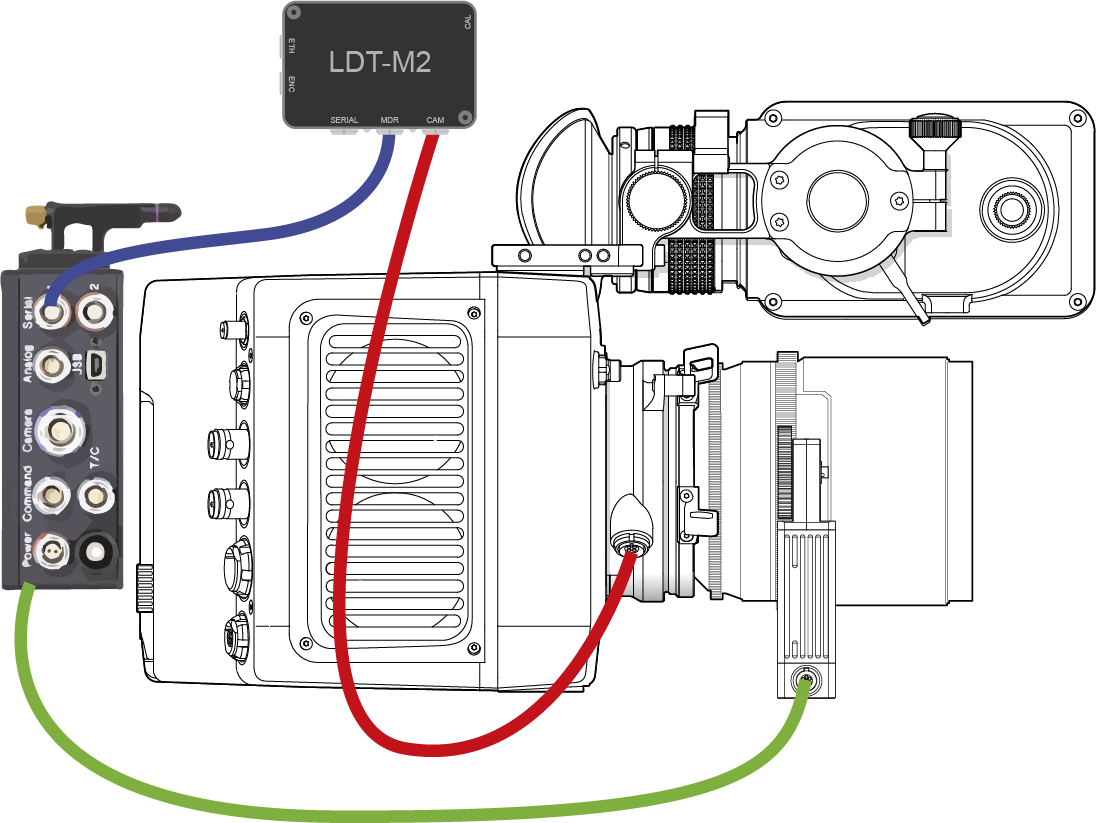
- Mount the LDT-M2 to the camera,
- Connect the MDR port of the LDT-M2 to a Serial port on the Preston MDR using the blue booted MDRP cable,
- Connect the LBUS (CAM) port of the LDT-M2 to an LBUS port on the camera using the red booted LBUS cable,
- Rig the Preston and Preston motors in the way they will be used on the day,
- Calibrate Preston motors (check Preston calibration method here).
If using an LDT-E series with a Preston, these are calibrated by the same command as the Preston.
If not using a Preston and only the LDT-E series encoders - calibration is done from the blue button on the LDT-M2 (see here).
¶ Setting up the Preston MDR
It is essential to update all Preston firmware.
Use an MDR-3 for building lens tables (MDR4 can be used for normal operation if required).
Disable F-Maps on the HU3/HU4 when building lens tables on the camera (F-maps can be used during normal operation).
Setup the Focus / Iris / Zoom direction for normal use on the Preston handsets.
¶ Calibrating the Preston with the LDT-M2
¶ Initial or Reboot Calibration
On powering up or reboot, calibration of the Preston motors needs to be done from the camera:
- Alexa Mini LF:
Menu > ECS > Calibrate All Motors - Alexa 35:
Menu > Lens & ECS > Calibrate All Motors
¶ Routine Calibration
There are currently 2 firmwares in circulation that require a different action from the user to calibrate the Preston motors.
If running Firmware 2.09 or below - calibrate the Preston from the blue button on the LDT-M2.
If running firmware 2.10 or above - calibrate the Preston from MDR as normal.
¶ Settings for the Arri ALEXA Mini/ALEXA Mini LF
The Camera’s internal lens mount must be disabled in order to use the external LBUS connector.
-
Choose
MENU > System > Lens data > Lens Mount Settings -
Untick
Enable lens mount -
Change
Focus unittoImperial
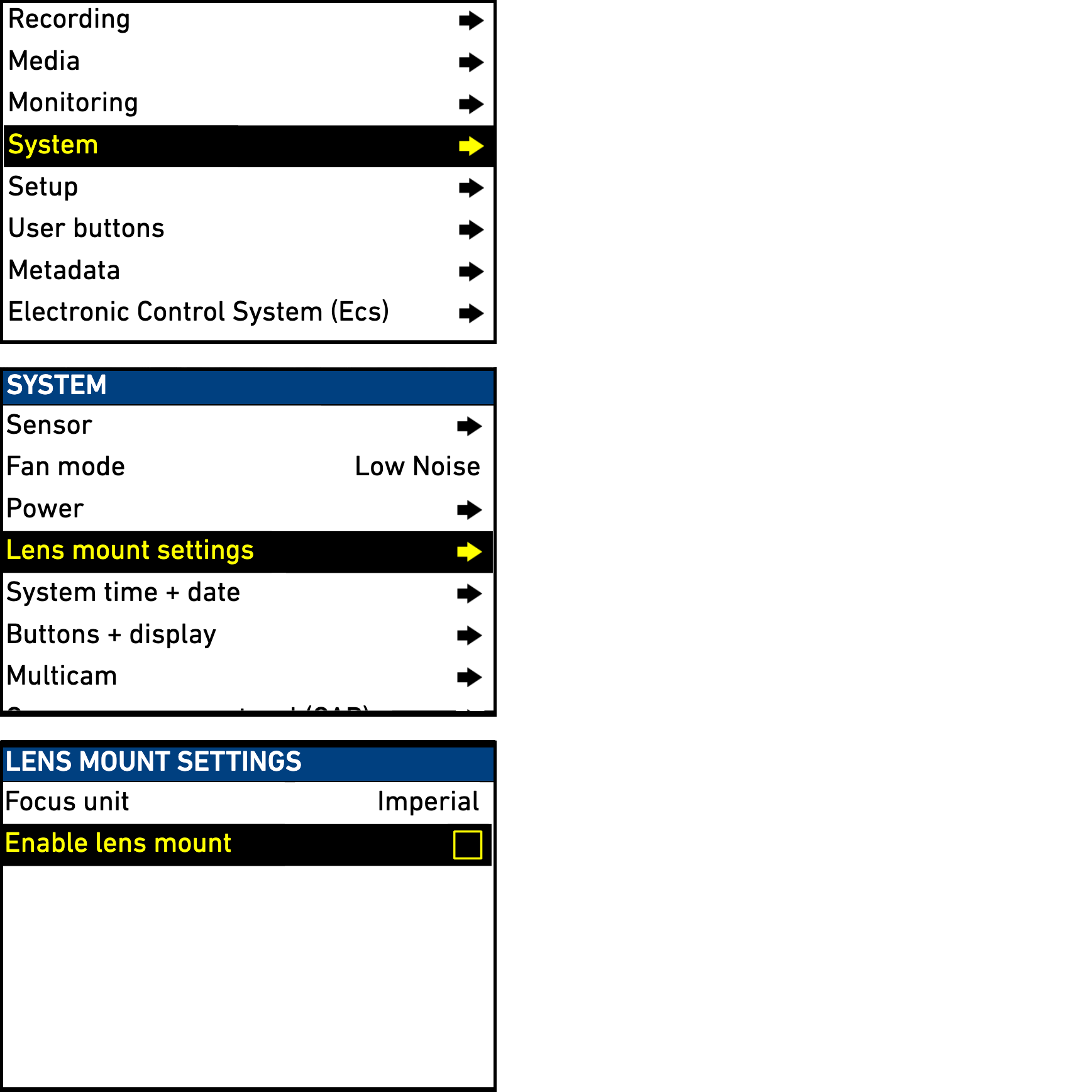
¶ Settings for the Arri ALEXA 35/ALEXA 265
The Camera’s internal lens mount must be disabled in order to use the external LBUS connector.
-
Choose
MENU > Lens & ECS -
Untick
Enable lens mount -
Change
Focus unittoImperial
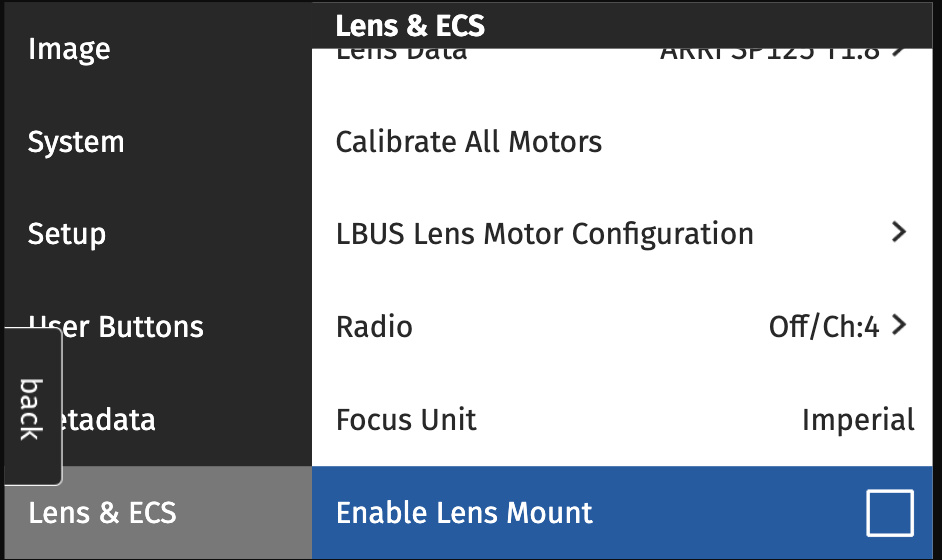
¶ Overlay Lens Data on a Monitor (Mini/MiniLF/35)
In order to display lens data as an overlay on an SDI monitor, do the following:
- Choose
MENU > Monitoring > SDI > SDI processing > Overlays > Status Components - Tick on
Lens dataandLens Focus Distance.
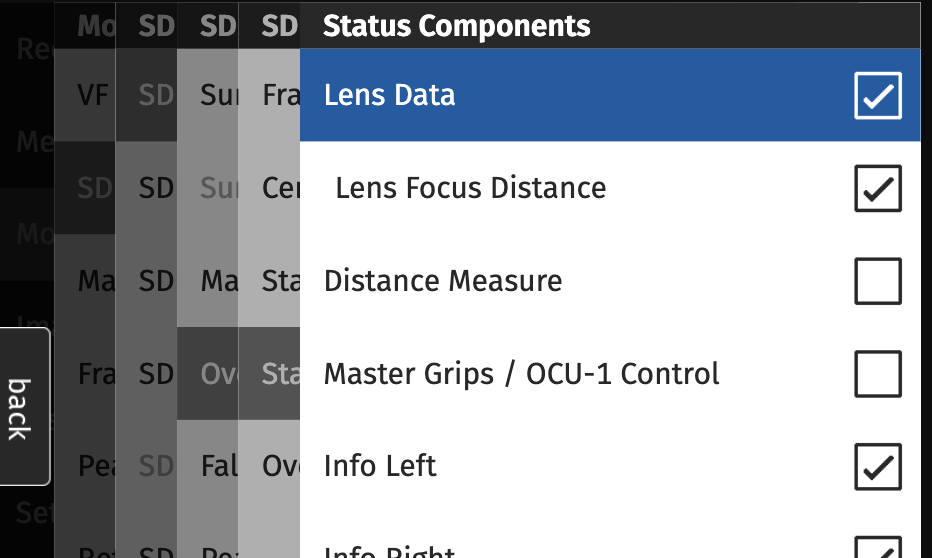
¶ Overlay Guide
¶ Mini LF
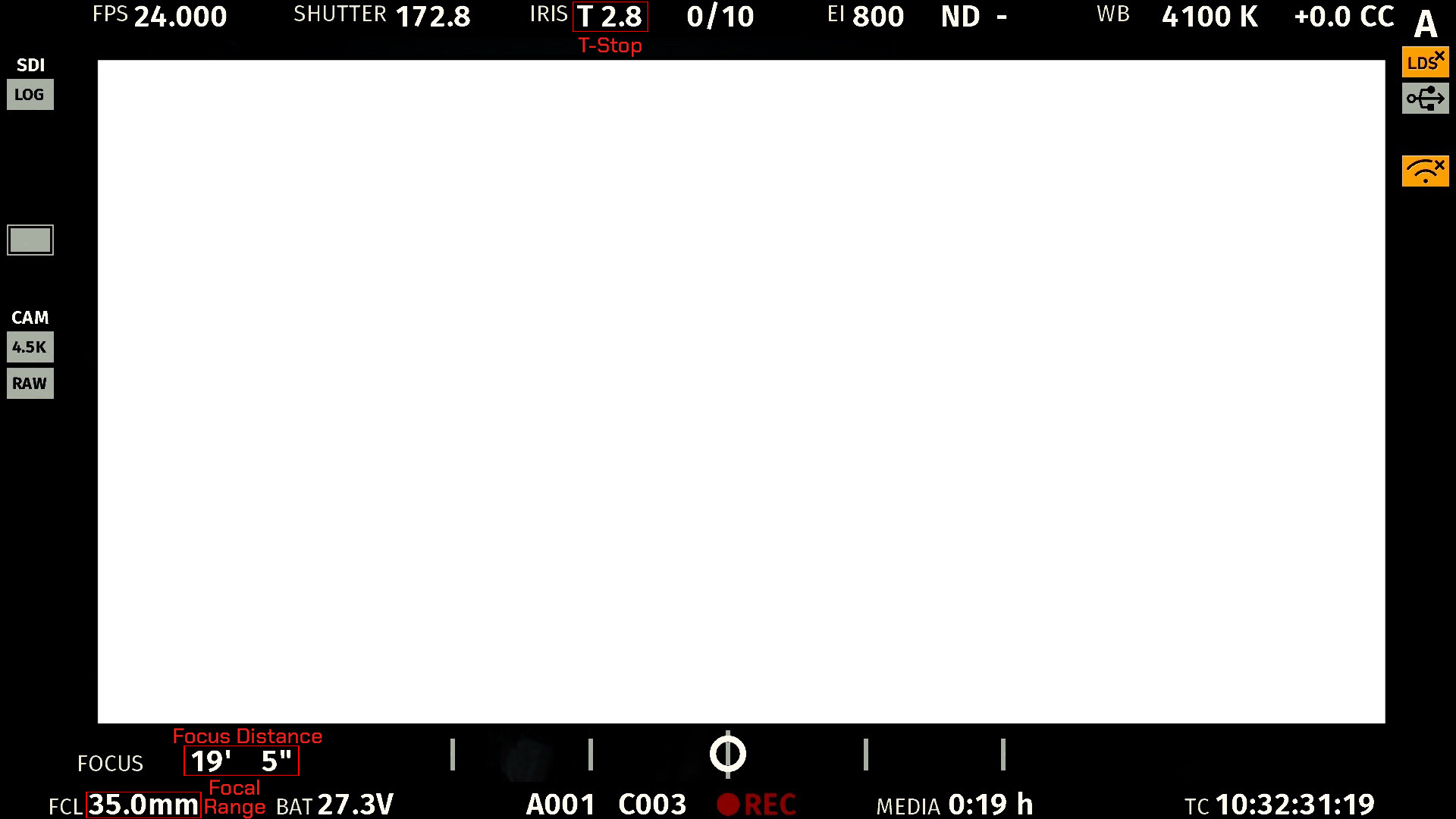
¶ Using a Lens Data Encoder (LDT-E Series)
Camera operators may wish to manually control the zoom instead of using a motor. A lens encoder can be used instead of a motor allowing the axis to spin freely whilst still providing the LDT-M2 with zoom data.
DCS provides a lens data encoder called LDT-E1. This device is plug and play, and does not require additional or separate lens tables to work.
A video tutorial explaining the set-up of the LDT-E1 can be found here
To use the LDT-E1:
Rig the LDT-E1 to the zoom axis,
Select “z” on the LDT-E1 using the physical button,
Connect the ENC cable to the port of the LDT-E1 and the ENC port of the LDT-A2.
The LDT-E1 can also be used to send focus or iris data to the LDT-M2 if required. Simply rig the encoder on the desired axis and change the physical button to that axis.
Note: the direction of the motor might need to be reversed: flipping the LDT-E1 unit to correct this.
¶ Setting the axis for the LDT-E1
Select an axis using the switch on the LDT-E1 to bound data correctly.
For example:
- Rig the LDT-E1 to the zoom axis,
- Connect the LDT-M2 and the LDT-E1 using the ENC cable.
- Select z on the LDT-E1 using the physical button,
The LDT-E1 can also be used to send focus or iris data to the LDT-M2 if required. Simply rig the encoder on the desired axis and change the physical button to that axis.
To calibrate the LDT-E1, press the calibrate button on the MDR. Then rotate the desired axis from one extreme to the other pausing for one second at each end.
¶ Using Multiple LDT-E Series Encoders
The LDT-E1 can be daisy chained with additional LDT-E2 encoders to deliver all lens axis data to an LDT-M2.
¶ Calibrating Only LDT-E Encoders
If solely using LDT-E series encoders with no Preston system, calibration is done by:
- holding down the blue button on the LDT-M2 for 3 seconds,
- manually rotating each axis from end to end.
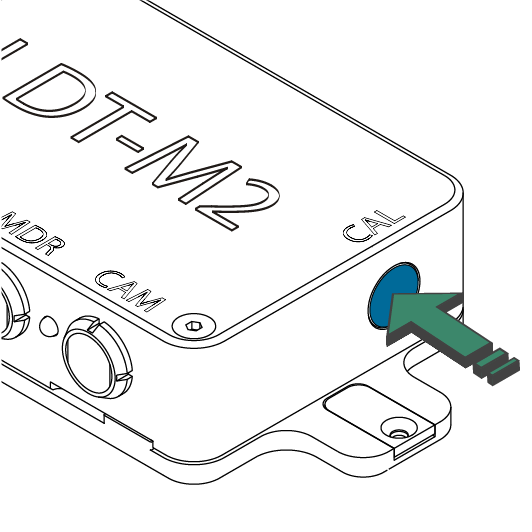
¶ Selecting a Lens Table
After a lens map has been created on the LDT-R2, converted, as per the Lens Mapping Guide, the lens tables can be imported and selected through the GUI of the camera:
- Choose
MENU > Electronic Control System (ECS) > Lens files - Choose
MENU > Electronic Control System (ECS) > Lens data > LDA - Select the Lens Table corresponding to the mounted lens and click
Use, - Calibrate the lens using the calibration option on the ECS menu or by calibrating the MDR.
Each axis in the LBUS Motor Configuration menu should be set to 'Left', in order to use lens map the correct direction which they were created in.
¶ Serial Loop Through for 3rd Party Devices
The LDT-M2 is equipped with a serial port that works as a passthrough for several devices. This is benifical for when an MDR does not have a spare serial port. Users intending to utilise this port should conduct comprehensive testing of the entire setup and connected devices to preemptively address any potential compatibility issues.
¶ Using a Light Ranger with the LDT-M2
It is recommended that the Light Ranger is used through the serial port of the Preston MDR-3 or MDR-5.
If the LDT's serial pass-through is required, then please get in touch with DCS.
- Email: info@dcs.film
- Phone: +44 (0) 20 8895 6592
DCS would encourage that this setup is fully tested before production begins, to detect any compatibility issues with the user’s setup.
¶ Shooting a Test
When shooting test footage, allow approximately one hour per camera type being used on the production. A test will involve recording the metadata with a camera and recording a separate feed from the camera with an overlay to verify the data is correct at the final stage of the test. We recommend using a zoom lens (if any are being used during the shoot) in order to check all three axes.
- Rig and set-up the camera and LDT as per the instructions in this manual,
Do not run the camera without the LDT attached.
For Each test a written visual representation of the FIZ values is required, for instance a clapper board with the lens values written on it.
¶ Test One - Static Test (Prime or Zoom)
- Set each axis to a value e.g. T-Stop 4, Focal length 22mm, Focus distance 6ft,
- Write on the board the test number, the lens name, and the values of each axis,
- Record a 10 second clip
¶ Test Two - Static Test (Different Prime or Zoom)
- Set each axis to a different value than test one e.g. T-Stop 5.6, Focal length 45mm, Focus Distance 30ft,
- Write on the board the test number, the lens name, and the values of each axis,
- Record a 10 second clip
¶ Test Three - Racking Test (Zoom Lens)
- Set each axis to a value e.g. T-Stop 4, Focal length 22mm, Focus Distance 6ft,
- Write on the board the test number, the lens name, the static values of each axis, and the range of the span of each axis (e.g. Iris T1.8 - T22, Focus 16"-Inf, Zoom 15mm - 30mm)
- Record a clip,
- During the recording, rack each axis one at a time, starting at the static number rotating the axis from one end to the other and returning to the static number.
¶ Final Steps
- Extract the lens medatada from the ARRIRAW,
- Merge the extracted CSV files to the EXR,
- Compare the metadata of the EXR file to the overlay footage.
¶ Lens Link Support
The LDT-M2 is compatible with the Lens Link workflow to enable motor control at a greater range.
This setup requires the DCS Bridge.
The DCS Bridge does not have passthrough for other devices such as CineRT or Light Ranger.
- Connect the DCS Bridge's EXT port to the LDT-M2's serial port using the blue booted MDRP cable,
- Power the DCS Bridge with the PWRG or PWRH cable.
For further guidance on this workflow, please refer to the Lens Link Manual.